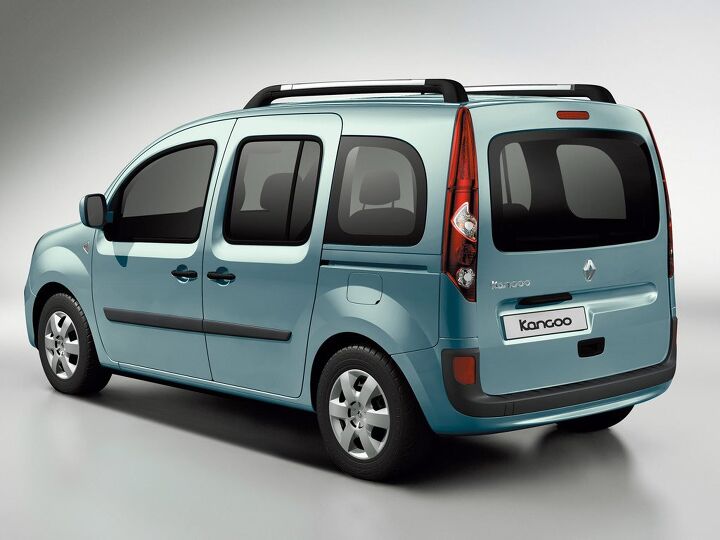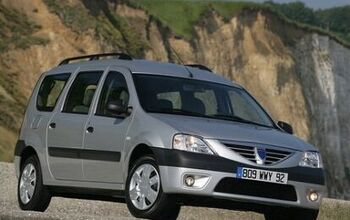Review: 2008 Renault Kangoo 1.5 Diesel

It may come off as odd to road test a French car in Sweden. Play along because as you’ll soon discover no country’s better-suited for the Renault Kangoo. During my brief sojourn in Sweden, I’ve decided Swedes are the Earth’s most utilitarian people. Nowhere else in the Western world do the women own as few shoes or the men know as few jokes. In automotive terms, the Swedish penchant for simplicity has translated into a decades-long love affair with the most utilitarian of all automotive species: the station wagon. The Kangoo is Renault’s foray into the compact hauler market. On paper, it’s a shoo-in: it’s even uglier than an estate, it’s more practical and it consumes less fuel with the optional diesel engine! In other words, what French car could possibly be more Swedish?
Aesthetically, I’d say the Kangoo has a decidedly European character. That’s not a compliment. Like many European interpretations of the budget automobile, it lacks any flair or machismo. The bubbly front sticks out meekly from the whole, its tiny lights giving it the air of a mouse trying to avoid a congestion charge in central London. Meanwhile, the middle lords disproportionately over the front, but arrives too late to the party to assert any character. It would look perfectly at home schlepping around abused suitcases at Charles de Gaulle airport. The styling is possibly an attempt at minimizing the drag coefficient for a continent where fuel costs slightly less than black market infants. Unfortunately, it’s not appeasing to see a rakish front morphing into a big boxy rear. And at the rear, more disaster lurks in the form of asymmetrical doors and a large plastic bracket outlining both sides of the ass-end.
Obviously, the Kangoo does some things better than others, and I’d say it does inanimate objects the best. That’s because no disassembled Ikea dining set would dare complain about the hard plastics and aesthetically boring instrument panel which RSVP’ed but then failed to meet my inflated European expectations. The seats are adequate, though thigh support could be better. I suppose being brainwashed about European sensibilities on car discussions forums for years does that, but this interior wouldn’t look out of place in a Ford Ranger. You can live with it, but would you want to? On the plus side, at least the gear lever isn’t much of a reach from the pilot.
As a driving machine, the Kangoo is a mixed bag. It adeptly splits the difference between big, ungainly car and small, nimble car. The ride is comparable to a typical econobox, say a Civic or a Cobalt. That’s probably because its DNA originates in the compact Mégane. However, it won’t take too many roundabouts to make you hate the momentous body roll, amplified by the car’s ridiculously high center of gravity. Tall and skinny together unfailingly produce understeer, and the Kangoo has both in droves. Conversely, the Kangoo’s seating position is majestically high and offers a commanding view of the road ahead.
The 1.5L diesel is reasonably peppy and miraculous with a full charge, being competent for most of its rev range. Obviously, at 1.5L, you’d never call it a stump-puller. It’s also far too noisy to pay tribute to the country that produced Berlioz and Debussy.
On the plus side, the towering storage area is the king of practicality. It can hold furniture, bikes, humans, couches—even the kitchen sink—all without the need to fold a seat or remove the spare tire. Any transplanted Baghdadi deliveryman navigating the cobblestone
micro-streets in Europe would appreciate the privacy, practicality and tirelessness of this rolling depot.
As a value proposition is where the Kangoo suffers in the eyes of the overtaxed Swede. The base Kangoo sells for a deceptively low 107,000 Swedish crowns. Once you start optioning it out (with such decadent amenities as rear passenger seats), it’s difficult to keep it under 125,000. It’s Daedulus flying too close to the sun. The sun, in this case, is off-lease Volvo or Saab wagons that have benefited from precipitous depreciation. These natives feature a moderate upgrade in road manners, a tremendous upgrade in refinement, and an immeasurable upgrade in aesthetics for only a few thousands more. Sure, you’ll sacrifice somewhat in schleppability, but it’s a price most Swedes have eagerly paid and will continue to eagerly pay.
The result is that the Kangoo toils away mostly as a niche-market, ultra-light commercial vehicle, while the family van version is a rare sight. In the rest of Europe, the Scénic variant of this platform has long fallen by the wayside. That doesn’t make it an abject failure but more of a testament to the fact sometimes form will trump function—even in Sweden. Maybe that’s why the girls here are so pretty.

Latest Car Reviews
Read moreLatest Product Reviews
Read moreRecent Comments
- W Conrad I'm not afraid of them, but they aren't needed for everyone or everywhere. Long haul and highway driving sure, but in the city, nope.
- Jalop1991 In a manner similar to PHEV being the correct answer, I declare RPVs to be the correct answer here.We're doing it with certain aircraft; why not with cars on the ground, using hardware and tools like Telsa's "FSD" or GM's "SuperCruise" as the base?Take the local Uber driver out of the car, and put him in a professional centralized environment from where he drives me around. The system and the individual car can have awareness as well as gates, but he's responsible for the driving.Put the tech into my car, and let me buy it as needed. I need someone else to drive me home; hit the button and voila, I've hired a driver for the moment. I don't want to drive 11 hours to my vacation spot; hire the remote pilot for that. When I get there, I have my car and he's still at his normal location, piloting cars for other people.The system would allow for driver rest period, like what's required for truckers, so I might end up with multiple people driving me to the coast. I don't care. And they don't have to be physically with me, therefore they can be way cheaper.Charge taxi-type per-mile rates. For long drives, offer per-trip rates. Offer subscriptions, including miles/hours. Whatever.(And for grins, dress the remote pilots all as Johnnie.)Start this out with big rigs. Take the trucker away from the long haul driving, and let him be there for emergencies and the short haul parts of the trip.And in a manner similar to PHEVs being discredited, I fully expect to be razzed for this brilliant idea (not unlike how Alan Kay wasn't recognized until many many years later for his Dynabook vision).
- B-BodyBuick84 Not afraid of AV's as I highly doubt they will ever be %100 viable for our roads. Stop-and-go downtown city or rush hour highway traffic? I can see that, but otherwise there's simply too many variables. Bad weather conditions, faded road lines or markings, reflective surfaces with glare, etc. There's also the issue of cultural norms. About a decade ago there was actually an online test called 'The Morality Machine' one could do online where you were in control of an AV and choose what action to take when a crash was inevitable. I think something like 2.5 million people across the world participated? For example, do you hit and most likely kill the elderly couple strolling across the crosswalk or crash the vehicle into a cement barrier and almost certainly cause the death of the vehicle occupants? What if it's a parent and child? In N. America 98% of people choose to hit the elderly couple and save themselves while in Asia, the exact opposite happened where 98% choose to hit the parent and child. Why? Cultural differences. Asia puts a lot of emphasis on respecting their elderly while N. America has a culture of 'save/ protect the children'. Are these AV's going to respect that culture? Is a VW Jetta or Buick Envision AV going to have different programming depending on whether it's sold in Canada or Taiwan? how's that going to effect legislation and legal battles when a crash inevitibly does happen? These are the true barriers to mass AV adoption, and in the 10 years since that test came out, there has been zero answers or progress on this matter. So no, I'm not afraid of AV's simply because with the exception of a few specific situations, most avenues are going to prove to be a dead-end for automakers.
- Mike Bradley Autonomous cars were developed in Silicon Valley. For new products there, the standard business plan is to put a barely-functioning product on the market right away and wait for the early-adopter customers to find the flaws. That's exactly what's happened. Detroit's plan is pretty much the opposite, but Detroit isn't developing this product. That's why dealers, for instance, haven't been trained in the cars.
- Dartman https://apnews.com/article/artificial-intelligence-fighter-jets-air-force-6a1100c96a73ca9b7f41cbd6a2753fdaAutonomous/Ai is here now. The question is implementation and acceptance.





































Comments
Join the conversation
Having been a passenger in a van version of one of these for many hundreds (if not thousands) of miles in one of these, I can tell you several things. A) They are dull. B) They wobble around roundabouts and understeer like buggery. C) They aren't very fast. However, most importantly is... D) You can thrash the hell out of the engine and gearbox - give it minimal maintenance and it will still run until doomsday. The van I had been passenger in had done nearly 100K miles on one oil change and no other maintenance, routinely hauling far more stuff than was supposed to go in it and often pulling trailers loaded with 1-2 tons of aggregate or concrete. Oh and not to mention the fact that my friend once punted a Saab through a brick wall by ramming it with this same Kangoo van and the van was still driveable. This poor little van was abused beyond what most cars/vans should expect and it is still passing MOT's and driving around to this day. So Dull - Yes, Too tall - Yes, Absolutely unbreakable? Yup!
I own a new Kangoo & if your looking for a box that drives like a hatchback forget it but if you want cheap, functional & comfortable you've found it. I've done a review of the new kangoo www.campervanforsale.co.uk/new_kangoo_review.htm